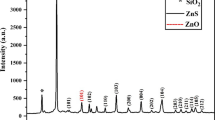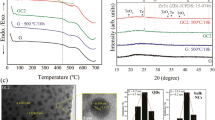Abstract
The spectra of the optical density and luminescence and dielectric spectra of crystalline nanoparticles (NPs), as well as micro- and nanodendrites of zinc and tin oxides in silicate nanoporous glass (NPG) with the average pore size of 25 nm, are presented. Oxide nanoparticles were synthesized in the bulk of nanoporous glass by the method of thermodissociation of zinc and tin salts. Oxide nanodendrites were synthesized by the oxidation of zinc and tin nanodendrites which were grown in glass pores via the method of electrolysis. It is demonstrated that the luminescence of nanoparticles and nanodendrites of Zn and Sn is caused by defects in the crystal structure. The optical and dielectric properties of the nanocomposites with nanoparticles and nanodendrites are compared. The obtained results can be used to create chemical and biological sensors, as well as in photocatalysis.









Similar content being viewed by others
REFERENCES
Hamanaka, Y., Nakamura, A., Omi, S., Del Fatti, N., Vallée, F., and Flytzanis, C., Ultrafast response of nonlinear refractive index of silver nanocrystals embedded in glass, Appl. Phys. Lett., 1999, vol. 75, pp. 1712–1714.
Klyukin, D., Dubrovin, V., Pshenova, A., Putilin, S., Shakhverdov, T., Tsypkin, A., Nikonorov, N., and Sidorov, A., Formation of luminescent and nonluminescent silver nanoparticles in silicate glasses by near-infrared femtosecond laser pulses and subsequent thermal treatment: The role of halogenides, Opt. Eng., 2016, vol. 55, p. 067101.
Lu, Y. and Chen, W., Sub-nanometre sized metal clusters: From synthetic challenges to the unique property discoveries, Chem. Soc. Rev., 2012, vol. 41, pp. 3594–3623.
Xue, R., Wang, X., Chen, X., Zhan, M., and Qi, S., Transparent stretchable composite conductor based on silvernanowires with hybrid structure, J. Mater. Sci., 2016, vol. 51, pp. 7211–7219.
Nishi, H., Asami, K., and Tatsuma, T., CuS nanoplates for LSPR sensing in the second biological optical window, Opt. Mater. Express, 2016, vol. 6, pp. 1043–1048.
Shalaev, V.M., Optical negative-index metamaterials, Nat. Photon., 2007, vol. 1, pp. 41–48.
Kam, K.C. and Doeff, M.M., Electrode materials for lithium ion batteries, Mater. Matters, 2012, vol. 7, pp. 56–58.
Ferry, V.E., Sweatlock, L.A., Pacifici, D., and Atwater, H.A., Plasmonic nanostructure design for efficient light coupling into solar cells, Nano Lett., 2008, vol. 8, pp. 4391–4397.
Liang, Y.-C., Lung, T.-W., and Wang, C.-C., Visible photoassisted room-temperature oxidizing gas-sensing behavior of Sn2S3 semiconductor sheets through facile thermal annealing, Nanoscale Res. Lett., 2016, vol. 11, pp. 505–508.
Joshi, R.K. and Kruis, F.E., Influence of Ag particle size on ethanol sensing of SnO1.8:Ag nanoparticle films: a method to develop parts per billion level gas sensors, Appl. Phys. Lett., 2006, vol. 89, 153116.
Wang, J.X., Sun, X.W., Yang, Y., Huang, H., Lee, Y.C., Tan, O.K., and Vayssieres, L., Hydrothermally grown oriented ZnO nanorod arrays for gas sensing applications, Nanotechnology, 2006, vol. 17, pp. 4995–4998.
Peterson, R.B., Fields, C.L., and Gregg, B.A., Epitaxial chemical deposition of ZnO nanocolumns from NaOH solutions, Langmuir, 2004, vol. 20, pp. 5114–5118.
Duan, J., Gong, J., Huang, H., Zhao, X., Yu, Z.-Z., and Yang, S., Multiform structures of SnO2 nanobelts, Nanotechnology, 2007, vol. 18, 055607.
Jung, Y., Ko, D.-K., and Agarwal, R., Synthesis and structural characterization of single-crystalline branched nanowire heterostructures, Nano Lett., 2007, vol. 7, pp. 264–268.
Dubrovin, V.D., Ignatiev, A.I., Nikonorov, N.V., Sidorov, A.I., Shakhverdov, T.A., and Agafonova, D.S., Luminescence of silver molecular clusters in photo-thermo-refractive glasses, Opt. Mater., 2014, vol. 36, pp. 753–759.
Bochkareva, E.S., Nikonorov, N.V., Podsvirov, O.A., Prosnikov, M.A., and Sidorov, A.I., The formation of sodium nanoparticles in alkali-silicate glass under the action of the electron beam and thermal treatments, Plasmonics, 2016, vol. 11, pp. 241–246.
Brunkov, P.N., Lipovskii, A.A., Melekhin, V.G., Red’kov, A.V., and Statsenko, V.V., Formation of silver fractal structures in ion-exchange glasses under poling, Tech. Phys., 2015, vol. 60, pp. 270–274.
Doi, A. and Asakura, N., Dendrites creating in silver metaphosphate glass treated by direct current of high density, J. Mater. Sci., 2001, vol. 36, pp. 3897–4002.
Kreisberg, V.A. and Antropova, T.V., Changing the relation between micro- and mesoporosity in porous glasses: the effect of different factors, Microporous Mesoporous Mater., 2014, vol. 190, pp. 128–138.
Gutina, A., Antropova, T., Rysiakiewicz-Pasek, E., Virnik, K., and Feldman, Y., Dielectric relaxation in porous glasses, Microporous Mesoporous Mater., 2003, vol. 58, pp. 237–254.
Antropova, T.V., Drozdova, I.A., Vasilevskaya, T.N., Volkova, A.V., Ermakova, L.E., and Sidorova, M.P., Structural transformations in thermally modified porous glasses, Glass Phys. Chem., 2007, vol. 33, no. 2, pp. 109–121.
Hunt, H.C. and Wilkinson, J.S., Optofluidic integration for microanalysis, Microfluid. Nanofluid., 2008, vol. 4, pp. 53–79.
Esikova, N.A., Evstrapov, A.A., Bulyanitsa, A.L., and Antropova, T.V., Study features of the change of the fluorescence signal of the sensor element based on porous glass on the concentration of labeled insulin, Glass Phys. Chem., 2015, vol. 41, no. 1, pp. 89–92.
Girsova, M.A., Firstov, S.V. and Antropova, T.V., The influence of the bismuth concentration and heat treatment on the properties of bismuth-containing high-silica glass: II. Luminescence properties, Glass Phys. Chem., 2019, vol. 45, no. 2, pp. 98–103.
Sokolov, V.O. and Sulimov, V.B., Theory of twofold coordinated silicon and germanium atoms in solid silicon dioxide, Phys. Status Solidi B, 1994, vol. 186, pp. 185–190.
Feder, J., Fractals, New York, London: Plenum, 1988.
Vasilevskaya, T.N. and Antropova, T.V., Small-angle X-ray scattering study of the structure of glassy nanoporous matrices, Phys. Solid State, 2009, vol. 51, no. 12, pp. 2537–2541.
Funding
This study was performed with the financial support of the Ministry of Education and Science of the Russian Federation (project no. 16.1651.2017/4.6).
Nanoporous glasses were synthesized at the Grebenshchikov Institute of Silicate Chemistry of the Russian Academy of Sciences within the Fundamental Scientific Research Program of the State Academies of Sciences for 2013–2020 (project no. 0097-2019-0015).
The electron microscopic studies were carried out using the equipment of the Federal State-Funded Research Center “Materials Science and Diagnostics in Advanced Technologies,” supported by the Russian Ministry of Education and Science (unique project identifier RFMEFI62117X0018).
Author information
Authors and Affiliations
Corresponding author
Ethics declarations
The authors declare that they have no conflict of interest.
Additional information
Translated by D. Marinin
Rights and permissions
About this article
Cite this article
Sidorov, A.I., Tung, N.D., Van Wu, N. et al. Optical and Dielectric Properties of Nanocomposites Based on Zinc and Tin Oxides in Nanoporous Glass. Glass Phys Chem 45, 439–446 (2019). https://doi.org/10.1134/S1087659619060221
Received:
Revised:
Accepted:
Published:
Issue Date:
DOI: https://doi.org/10.1134/S1087659619060221




